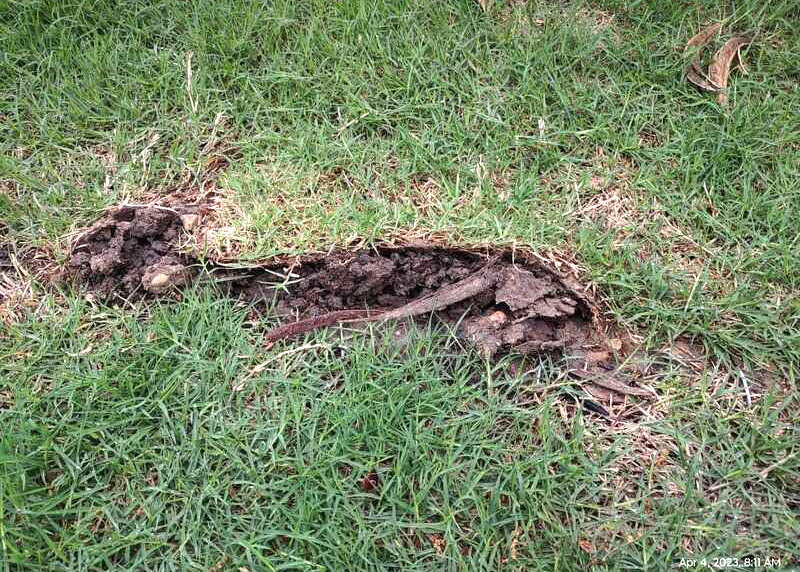Q&A – Ask Neil: April 13, 2023
(Please read these instructions carefully.)
Before you post your question, please look at recent issues to see if someone else has already asked it. You might find your answer there.
How to submit your question…
• Click the link provided below to post your question. After you submit your question, a new window will pop up giving you the address to which you can e-mail a photo to accompany your question. Clear, medium-resolution photos. (Try to avoid low-res thumbnail photos, please, in case I have to zoom in to see things.)
• Click here to post your question.
• Please only post your question one time.
• One question per reader, please.
• Please use this only for posting questions – not for standard emails.
• Watch for your answer in the following week’s e-gardens.
• I choose those of greatest general interest. For example, plant IDs seldom make the cut.
• I must have your first name or initials.
• I must have your city or county. (Texas is a very large state.)
QUESTION 1
WHAT’S WRONG WITH MY ST. AUGUSTINE?
Question: My St. Augustine lawn has a patchwork of dead grass all across the yard. From your book I’ve narrowed it down to possibly grub worms, take all root rot, brown patch or SAD. What do you think? Janice C., San Antonio.
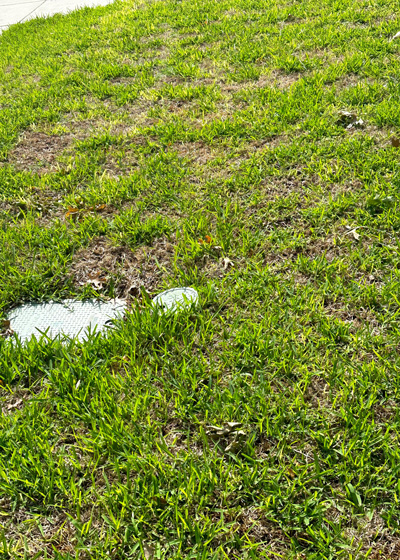
Answer: The first thing I think about is what time of year this question is being asked. Most St. Augustine issues are very seasonal. Then I look closely at the blades and the specific symptoms. Grub worms devour roots, so affected areas pull loose easily from the soil since the roots aren’t there to hold the soil. However, their damage isn’t usually this much like (to use your term) “patchwork.” Brown patch results in circular areas of dead grass blades – definitely not the case here since they’re not brown. St. Augustine decline (SAD) leaves no survivors, plus it’s not nearly as common now as it was several decades ago. We now have SAD-resistant types of St. Augustine making up most lawns. Take all root rot (TARR), however, occurs as grass tries to come out of winter dormancy. Patches of it fail to green up as it normally should (hence the other name, “take all patch”). Blades are alternately normal green and pale yellowish green or missing entirely, all within just a few inches of one another. This really does look like take all root rot. Try the fungicide Azoxystrobin to see if the lawn responds favorably.
QUESTION 2
HOW CAN I PREVENT FURTHER EROSION?
Question: Heavy shade prevents grass from growing beneath my red oak. Erosion has caused the oak’s roots and parts of the sprinkler system to become exposed. What can I plant that will stop further erosion? Terry W., Garland.
Answer: You need a groundcover that will form a dense root system. For that purpose, along our creek, I have used regular mondograss. It spreads well, endures shade perfectly and holds soil tenaciously. It can be planted at any time. If you need to bring a small amount of topsoil in to replace what has eroded away, but try not to bring more than one inch.
QUESTION 3
DO I NEED TO WORRY ABOUT SPLIT IN MY LACEBARK ELM?
Question: My lacebark elm has a split in its trunk, perhaps caused by the horrific cold in February 2021. It seems to be thriving, but I’m worried about its long-term viability. What should I be doing to help it recover? Jeff M., Northlake (Denton Co.)

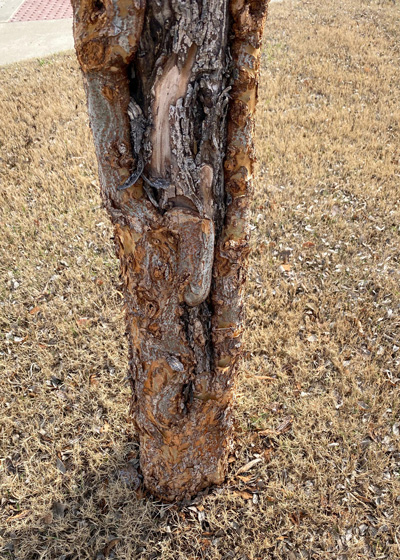
Answer: I can’t really tell if there may have been small branches that weren’t removed flush with the trunk or if something else could be causing the distorted growth of the wood beneath the bark, but there appears to be decay progressing. I see new bark trying to form, but I worry about the long-term strength of your tree against windstorms. One of my biggest peeves with lacebark elms is that they’re weakly rooted and always leaning. It looks like two of them in your photo are out of plumb, including the one in question. You can certainly leave it in place to see how it heals, or you could have a certified arborist examine it more closely on site. It does look like the root flare needs to be exposed. Soil seems to be too high on the trunk. It really needs to be dug and replanted so that it is perfectly vertical, but if you’re going to all that trouble, you’d be better off changing to another species entirely. (You asked for my opinion and I seem to have given you five or six.)
QUESTION 4
WHEN AND HOW OFTEN SHOULD SULFUR BE ADDED TO A LAWN?
Question: I had a soil test show that I need to add nitrogen and acid, both lacking. When and how often should I add sulfur to the grass? Tom W., Collin Co.
Answer: Your lawn fertilizer is going to contain sulfur – probably enough to meet the needs of your turfgrass. It’s quite rare to see a recommendation for the addition of sulfur for turf in Blackland Prairie soil such as what you have in Collin County. And nitrogen almost always shows up as deficient on soil tests. Depending on the type of turf that you have, I’m going to suggest you use a phosphorus-free lawn food (only nitrogen plus any small amount of potassium it happens to have) to feed your turf. Find one that has 30-40 percent of that nitrogen in slow-release form. It almost assuredly will have sulfur as a part of the nitrogen component. Feed bermuda turf every two months beginning early April through early October. Fertilize St. Augustine early April, early June and early September. Monitor the soil pH over an extended period of time and you’ll probably see favorable results.
QUESTION 5
WHY ARE NELLIE R. STEVENS LEAVES TURNING BLACK?
Question: I saw your answer about Nellie R. Stevens hollies’ leaves turning yellow. One of my three year-old plants has black leaves. Can I save it? Mary Ann L., Wood Co.
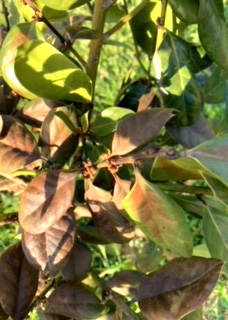
Answer: I tried my best to see your thumbnail photos. I see no signs of insects or diseases. This plant looks like it got marginally too dry at some point. I see this very often. Hollies don’t wilt in the conventional sense, so people often miss when they’re nearing the point of no return. Trim out the browned growth and let’s see where we are in a few weeks.
QUESTION 6
HOW DO I TREAT FOR THESE GREEN GROWTHS IN MY RED OAK?
Question: What is the best way to treat and eliminate the green ball-like growths on red oak trees? Bob O., Bedford.
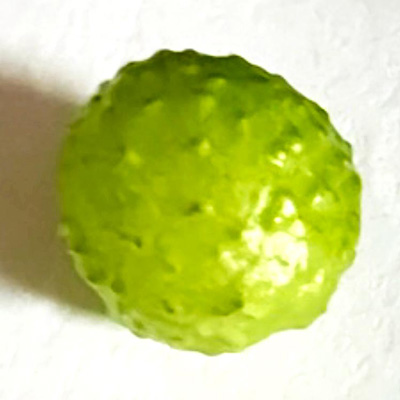
Answer: These are oak galls. There actually are many different species of gall-forming insects, each with its own characteristic types of galls. The female of the species lays her eggs in the leaf or twig tissues of the tree. The tree develops the swollen gall around the eggs in response, and the larvae develop within the protection of the galls. It’s a grand plan that works to the benefit of the insects. The good news is that it’s all harmless to the trees. The bad news is that there is no way to avoid or control them. As a wise entomologist with Texas A&M once told me, “You might as well just brag about them.”
QUESTION 7
WHY WOULD ONLY ONE OUT OF FOUR TRANSPLANTED APPLE TREES SURVIVE?
Question: I planted four apple trees in January. Two were purchased from a nursery and two were transplanted from another location. Two each, Fuji and Gala. Only one of the four has leafed out. Should I give them more time, or pull them out and try again? Jim I., Chandler (Henderson Co.).
Answer: It sounds to me like the three trees have been lost due to transplant shock. Even if they try to sprout out from their roots you don’t want to save them since that won’t be the Fuji or Gala that you wanted. It’s time to try again. By mid-April they should be leafed out and growing just as the one tree is.
QUESTION 8
HOW CAN I ELIMINATE WINTER GRASS THAT IS CHOKING OUT MY BERMUDAGRASS?
Question: I applied pre-emergent last fall at the recommended time, but now my lawn has been overtaken by winter grass that is choking out the bermuda. What can I do now to eliminate it? Mike S., Royse City.
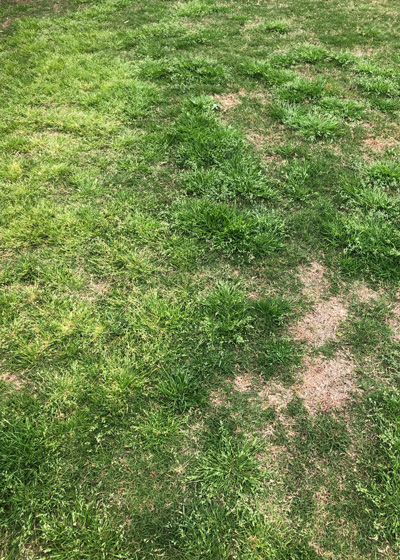
Answer: Unfortunately, there is no post-emergent control of grasses that can be applied at this point without harming your bermuda. The good news is that the winter grassy weeds like the annual bluegrass (Poa annua) you have will soon be dying out as temperatures climb into the 90s. They rarely persist very far into May. To avoid this problem next time around you might want to apply your fall pre-emergent a week earlier. The proper timing is between August 25 and September 5.
For the record, southern ag universities are reporting that annual bluegrass does show signs of tolerance to our common consumer pre-emergents. All three of the common products available to homeowners are out of the same category of pre-emergents, so this shortcoming is common to all of them. You may have seen my mention of that here in e-gardens late last summer.
QUESTION 9
WHY WOULD SPOTS OF GRASS KEEP POPPING UP IN SEAMS OF NEW SOD?
Question: I had bermuda sod planted 32 days ago. Everything is looking fine except one seam which keeps separating with clumps of soil pushing up in three places. I press it down late at night, and by morning it has popped up again – same three places. I’ve been told if it were a mole it wouldn’t be pushing up in the same three places. Can you help me? Joyce T., Highland Village.
Answer: Are there moles elsewhere in your neighborhood? If so, they do remain a possibility. They will push soil up and out to clear their tunnels. Here is better help than I can offer from wildlife management people with Texas A&M. https://agrilife.org/txwildlifeservices/files/2016/08/Moles.pdf


